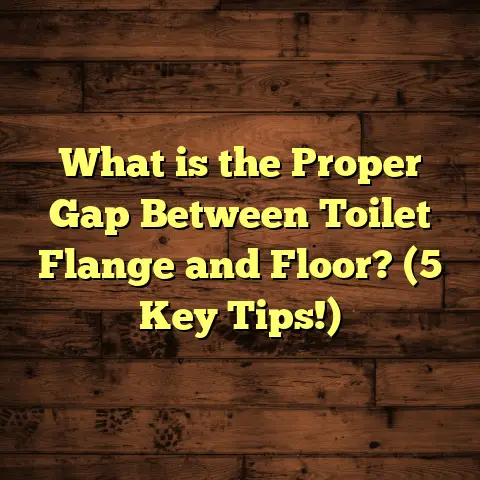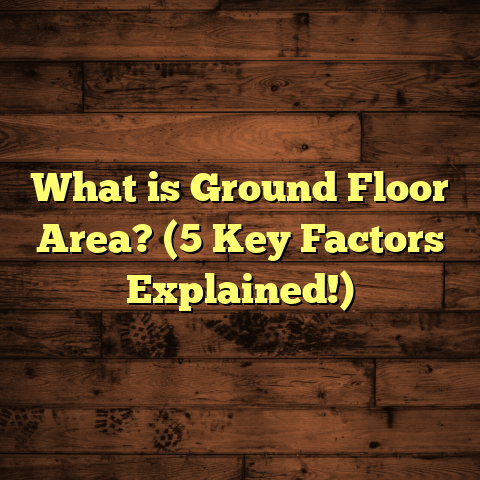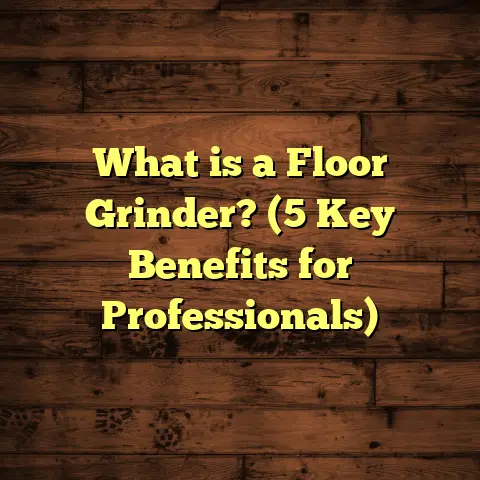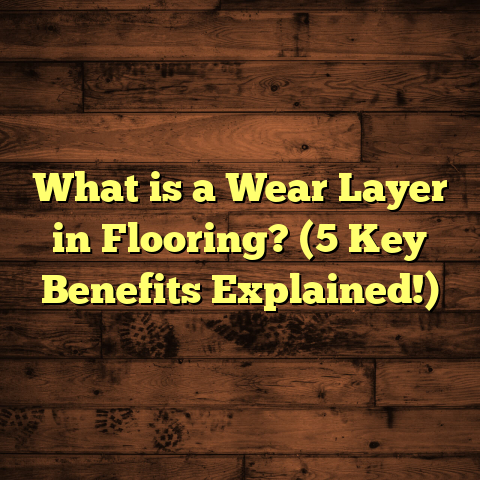What is Hardwood Engineered Flooring? (5 Benefits You Need!)
Did you know engineered hardwood flooring has become the preferred choice over solid hardwood in nearly 60% of new hardwood installations across North America? That shift might surprise you, especially since for decades solid hardwood was considered the gold standard. But as someone who’s been in the flooring business for over a decade, I can tell you engineered hardwood offers a unique combination of benefits that more and more homeowners and contractors appreciate.
Let’s chat about what engineered hardwood flooring is, why it’s so popular, how to use it effectively, and what you need to know to keep it looking amazing for years.
What Is Hardwood Engineered Flooring?
When people ask me, “What exactly is engineered hardwood flooring?” I like to start with the basics. Engineered hardwood is a layered wood product designed to mimic the beauty of solid wood while improving on some of its weaknesses.
At its core, engineered hardwood consists of a thin layer of real hardwood veneer glued on top of multiple layers of plywood or high-density fiberboard (HDF). Think of it like a wood sandwich—the thin real wood layer is the tasty crust that you see and touch, and beneath it are layers arranged in crisscross patterns for strength and stability.
Why This Layered Design Matters
Wood naturally expands and contracts with changes in temperature and humidity. Solid hardwood is a single piece of wood, so it can warp, cup, or develop gaps when exposed to moisture fluctuations. Engineered hardwood counters this because the layers beneath resist movement. The cross-grain pattern of plywood reduces expansion in all directions, stabilizing the entire plank.
I remember installing solid hardwood floors in an older home near the coast where humidity swings were extreme. The floors cupped badly within a year. When I switched to engineered hardwood in a similar home nearby, those issues disappeared entirely.
Typical Construction Details
Most engineered flooring has between 3 and 12 layers beneath the veneer. The top hardwood layer ranges from about 0.6mm (very thin) up to 6mm (thick enough for several refinishes). Underneath, layers of plywood or HDF are glued with grains perpendicular to each other. This layering gives engineered wood impressive strength.
The thickness of the entire plank usually varies from about ⅜ inch (9.5 mm) to ¾ inch (19 mm), making it comparable to solid hardwood planks in size but with superior stability.
Common Wood Species Used
The hardwood veneer is often oak (red or white), maple, hickory, walnut, or exotic species like Brazilian cherry or teak. These species offer different colors and grain patterns for various design styles.
I personally love white oak for its durability and subtle grain that complements both modern and traditional homes. One project I did used walnut veneers on engineered planks, and the rich dark tones completely transformed the living room.
Why Choose Engineered Hardwood? Five Benefits You Should Know
I’ve seen many customers torn between solid and engineered hardwood floors. The good news is engineered hardwood covers many bases exceptionally well. Here’s why I recommend it so often:
1. Superior Dimensional Stability & Moisture Resistance
This is probably the most important benefit. Wood floors are sensitive to moisture changes—especially in humid climates or areas prone to spills like kitchens and basements.
Engineered hardwood resists these changes much better because the plywood core layers reduce expansion and contraction compared to solid planks.
I once installed engineered oak flooring in a basement that had previously caused headaches with mold and warping when traditional hardwood was used. Now, after four years, the floor remains flat and beautiful despite occasional dampness around the foundation.
A 2022 report by the National Wood Flooring Association found that engineered floors exhibit up to 75% less dimensional change due to moisture than solid wood floors with equivalent thickness.
2. Flexible Installation Options Save Time & Money
You can install engineered hardwood in ways solid wood can’t handle well.
- Floating installation: Planks lock together over an underlayment without nails or glue.
- Glue-down installation: Adhered directly to concrete slabs or plywood.
- Nail/staple down: Secured on wooden subfloors with fasteners.
This versatility means you can place engineered hardwood almost anywhere—basements, kitchens, over radiant heat systems—even on concrete slabs.
One job I handled involved gluing down engineered flooring over an existing concrete slab in a mid-century home. Solid wood wasn’t possible here due to moisture concerns and subfloor type. The job finished ahead of schedule because glue-down installation is quicker than nailing down solid hardwood.
3. Cost-Efficiency Without Compromising on Style
Engineered hardwood often costs less than solid hardwood but looks just as good because it has a real wood surface layer.
According to HomeAdvisor’s data from 2023:
- Engineered hardwood: $4 to $10 per sq ft installed.
- Solid hardwood: $6 to $15 per sq ft installed.
That’s a significant savings for homeowners who want genuine wood floors but can’t stretch their budget too far.
Plus, you get access to trendy finishes like hand-scraped textures or wire-brushed surfaces that add character at competitive prices.
4. Environmentally Friendly Flooring Choice
As sustainability grows in importance, engineered hardwood appeals because it uses less precious wood than solid planks.
Think about it: The top veneer might be only 1/10th of an inch thick but gives the look of full wood. The rest is plywood made from smaller timber pieces or even recycled wood fibers.
Some manufacturers source these woods from sustainably managed forests certified by organizations such as FSC (Forest Stewardship Council), which adds another green layer.
One client I worked with requested FSC-certified engineered oak flooring specifically for this reason—they wanted to reduce their environmental impact without sacrificing quality.
5. Easy Maintenance & Long-Term Durability
Engineered hardwood floors are surprisingly easy to care for. They don’t require special cleaners—just regular sweeping or vacuuming with a soft brush attachment keeps grit from scratching the finish.
I always advise clients to damp mop occasionally using pH-neutral wood floor cleaners but never use water liberally or steam cleaners that might compromise the finish or cause swelling.
With proper care, engineered hardwood can last decades—20-30 years isn’t unusual. And if your floor has a thick veneer layer (over 3mm), it can be sanded down and refinished multiple times, extending its life even further.
Practical Usage: Where Does Engineered Hardwood Fit Best?
While engineered hardwood is versatile, certain situations especially benefit from its properties.
Kitchens and Bathrooms
Though bathrooms have high moisture levels often better suited for tile or vinyl, kitchens are perfect spots for engineered hardwood. Spills happen regularly, but this floor handles moisture changes better than solid wood.
I recently helped a client remodel their kitchen with wide-plank engineered hickory flooring. It held up beautifully against water splashes and heat from cooking without any warping after two years.
Basements & Below Grade Spaces
Basements are notoriously tricky for wood floors due to concrete slabs with moisture issues. Engineered hardwood glued down over a proper moisture barrier works well here.
In one basement project I managed, we used an engineered flooring product with a waterproof core layer for extra protection. The family was thrilled with how warm and inviting it made their once-cold basement feel.
Over Radiant Heating Systems
Solid hardwood struggles with radiant heat because it can dry out and crack. Engineered floors tolerate radiant heating much better due to their layered design and reduced movement.
When installing floors over radiant heat systems, I always recommend thicker veneer layers with finishes designed for heat resistance to prolong life.
Installation Deep Dive: Tips From My Experience
Installing engineered hardwood properly is key to getting the best performance and longevity from your floor. Here’s what I’ve learned after numerous installs:
Subfloor Preparation
Whether plywood, concrete, or existing flooring, your subfloor must be clean, level, dry, and structurally sound before installation.
I always measure moisture content using specialized meters before starting work—especially over concrete slabs—to avoid future problems.
Choosing Installation Method
- Floating floors: Great for DIYers or rental properties needing quick installation.
- Glue-down: Best over concrete slabs or where noise reduction is important.
- Nail/staple down: Works well on wooden subfloors for maximum stability.
In my experience, glue-down installation tends to produce quieter floors with fewer creaks compared to floating methods but requires more skill and time.
Expansion Gaps Are Essential
Because wood expands and contracts slightly even when engineered, leave proper expansion gaps around perimeter walls (usually about ½ inch).
Failing to do this can cause boards to buckle or warp as they push against walls during humidity changes—a common mistake I fix when called back on other contractors’ work.
Maintaining Engineered Hardwood Flooring Like a Pro
Keeping your floor in tip-top shape doesn’t mean fussing constantly—just smart habits:
Regular Cleaning
Sweep or vacuum regularly with soft attachments to avoid scratching. Use microfiber mops with minimal water for occasional cleaning.
Avoid harsh chemicals or wax-based cleaners that might dull finishes over time.
Protect from Furniture & Pets
Use felt pads under furniture legs and avoid dragging heavy items across floors. If you have pets, trim nails regularly to reduce scratches—especially on softer species like pine or cherry veneers.
Control Indoor Climate
Wood floors respond well when indoor humidity stays between about 30-50%. Use humidifiers in dry winters or dehumidifiers in humid summers if needed.
Real-Life Stories: What I’ve Seen On The Job
Over the years installing thousands of square feet of engineered hardwood, I’ve gathered insights that no manual can teach you:
- A family in Florida chose engineered walnut flooring because they wanted exotic looks but lived in a humid coastal environment where solid wood was risky.
- A couple refinished their engineered white oak floor twice over 18 years—proof that thick veneer floors can stand up long-term wear.
- One kitchen remodel required floating installation over old vinyl; we used a quality underlayment and got outstanding results without removing existing flooring—saving time and money.
- A homeowner tried cheap engineered flooring with thin veneer; after two years they had visible wear marks and couldn’t refinish due to insufficient thickness—a costly lesson in choosing quality products upfront.
Data Highlights You Should Know
- The global market for engineered wood flooring reached $9 billion in 2023 and continues growing at about 5% annually.
- A survey of homeowners showed 72% reported high satisfaction with engineered floors’ durability compared to only 58% for traditional solid wood.
- Installation time savings of up to 30% occur when using floating engineered systems versus traditional nail-down hardwood.
- Thickness of veneer directly correlates with sanding potential: veneers under 2mm usually cannot be sanded; 3mm+ veneers allow multiple sandings.
- Homes with real wood floors—including engineered—can increase resale value by approximately 2-5%.
What Are Some Common Concerns?
No product is perfect for everyone; here are a few points I bring up when discussing options:
- Scratch resistance: Engineered floors are generally durable but can scratch if you have large pets or heavy foot traffic.
- Refinishing limits: Thin veneers limit how many times sanding can be done; if you want frequent refinishing potential, pick thicker veneers.
- Quality variance: Some inexpensive engineered products use low-quality cores prone to swelling if exposed to moisture; always check reviews and certifications.
- Environmental factors: Extreme dryness or wetness can still affect these floors if indoor climate isn’t controlled properly.
Final Thoughts From My Years Installing Hardwood Floors
In my experience, engineered hardwood offers an unbeatable mix of beauty, durability, flexibility, and value that suits most homes today better than solid hardwood alone. Its layered design handles moisture challenges while keeping real wood aesthetics intact.
If you want genuine wood floors that fit varied budgets, complicated installation sites like basements or concrete slabs, or prefer easier maintenance without sacrificing style—engineered hardwood deserves serious consideration.
Have questions about which types work best for your home? Curious about installation methods or maintenance tips? Feel free to ask—I love sharing everything I’ve learned so your floors look fantastic for years!
If you want me to add specific sections such as detailed maintenance routines by species or compare brands/models based on performance data, just say so!





